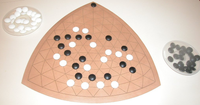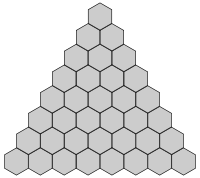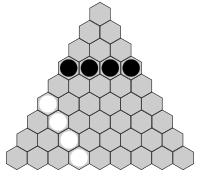
Y (game)
Encyclopedia

Y is an abstract strategy game
Abstract strategy game
An abstract strategy game is a strategy game, aiming to minimise luck, and without a theme. Almost all abstract strategy games will conform to the strictest definition of: a board or card game, in which there is no hidden information, no non-deterministic elements , in which two players or teams...
which was first described by Claude Shannon in the early 1950s. Y was independently invented in 1953 by Craige Schensted
Craige Schensted
Craige Eugene Schensted is a physicist who first formulated the insertion algorithm that defines the Robinson–Schensted correspondence; under a different form, that correspondence had earlier been described by Gilbert de Beauregard Robinson in 1938, but it is due to the Schensted insertion...
(now Ea Ea) and Charles Titus. It is a member of the connection game
Connection game
A connection game is a type of abstract strategy game in which players attempt to complete a specific type of connection with their pieces. This could involve forming a path between two or more goals, completing a closed loop, or connecting all of one's pieces so they are adjacent to each other....
family inhabited by Hex, Havannah, TwixT
TwixT
TwixT is a two-player abstract strategy game invented by Alex Randolph. It is a member of the connection game family, along with games such as Hex, Havannah, Y, PÜNCT and *Star...
, and others; it is also an early member in a long line of games that Ea Ea has developed, each game more complex but also more generalised.
Gameplay
Y is typically played on a triangular board with hexagonal spaces; the "official" Y board has three points with five-connectivity instead of six-connectivity, but it is just as playable on a regular triangle. Schensted and Titus' book Mudcrack Y & Poly-Y has a large number of boards for play of Y, all hand-drawn; most of them seem irregular but turn out to be topologically identical to a regular Y board.
Pie rule
The pie rule, sometimes referred to as the swap rule, is a meta-rule used to balance abstract strategy board games. Its use has been first reported in 1909 for a game from the Mancala family. Among recent games, Hex uses this rule...
can be used to mitigate any first-move advantage.
Rules
The rules are as follows:- Players take turns placing one stone of their color on the board.
- Once a player connects all three sides of the board, the game ends and that player wins. The corners count as belonging to both sides of the board to which they are adjacent.
The simple (regular) form of Y can be played by email
Play-by-mail game
Play-by-mail games, sometimes known as "Play-by-post", are games, of any type, played through postal mail or e-mail. One example, chess, has been played by mail for centuries . Another example, Diplomacy, has been played by mail since the 1960s, starting with a printed newsletter written by John...
, using Richard Rognlie's Play-By-eMail Server.
As in most connection games, the size of the board changes the nature of the game; small boards tend towards pure tactical play, whereas larger boards tend to make the game more strategic
Strategy
Strategy, a word of military origin, refers to a plan of action designed to achieve a particular goal. In military usage strategy is distinct from tactics, which are concerned with the conduct of an engagement, while strategy is concerned with how different engagements are linked...
.
Relations to other connection games

Mudcrack Y & Poly-Y also describes Poly-Y, the next game in the series of Y-related games; after that come Star
Star (board game)
Star is a two-player abstract strategy board game developed in by Craige Schensted . It was first published in 1983 in Games magazine. It is connection game, related to games such as Hex, Y, Havannah, and TwixT. Unlike these games, however, the result is based a player having a higher final...
and *Star
*Star
*Star is a complex abstract strategy game by Ea Ea, a designer of Y. It is a redevelopment of his earlier game Star.-Rules:*Star can be played on graphs of different sizes. The three shown boards have 105, 180, and 275 nodes of which 30, 40, and 50 are on the perimeter...
.
Criticisms
Y, like Hex, yields a strong first-player advantage. The standard approach to solving this difficulty is the "pie" rule: one player chooses where the first move will go and the other player then chooses who will be the first player.Y's chief criticism is that on the standard hexagonal board a player controlling center can easily reach any edge no matter what the other player does. This is because the distance from the center to an edge is only approximately 1/3 the distance along the edge from corner to corner. As a result, defending an edge against a center attack is very difficult.
Schensted and Titus attacked this problem with successive versions of the game board, culminating in the present "official" board with three pentagons inserted among the hexagons. They noted that were players to play on a hemisphere rather than a plane with hexagons, with the equator divided into three "sides" (each 1/3 the circumference of the hemisphere), the distance from the "north pole" of the hemisphere to the equator was 1/4 the circumference, and thus the distance ratio improved from 1/3 to 3/4. This made defending a side from a center attack much more plausible. Thus the present "official" board is essentially a geodesic dome half-hemisphere squashed flat into a triangle to provide this effect.
No draws
It has been formally shown that Y cannot end in a draw. That is, once the board is complete there must be one and only one winner. Hex can be straightforwardly viewed as a game of Y with certain hexagons already filled: and as such Y's proof extends to Hex as well.The first player wins
In Y the strategy-stealing argumentStrategy-stealing argument
In combinatorial game theory, the strategy-stealing argument is a general argument that shows, for many games, that the second player cannot have a winning strategy .The strategy-stealing argument applies to any symmetric game In combinatorial game theory, the strategy-stealing argument is a...
can be applied. It proves that the second player has no winning strategy. The argument is that if the second player had a winning strategy, then the first player could chose a random first move and then pretend that she is the second player and apply the strategy. An important point is that an extra pawn is not a disadvantage in Y. Y is a complete and perfect information game in which no draw can be conceived, so there is a winning strategy for one player. The second player has no winning strategy so the first player has one. It is nevertheless possible for the first player to lose by making a sufficiently bad move, since although that stone has value, it may have significantly less value than the second move -- an important consideration for understanding the nature of the pie rule.
If the "pie rule" is in force, however, the second player wins, because the second player can in principle evaluate whether or not the first move is a winning move and choose to invoke the pie rule if it is (thereby effectively becoming the first player).
It should be noted that in practice, assuming the pie rule is in force and the official Schensted/Titus board is being used, Y is very well balanced game giving essentially equal chances for any two imperfect mortal players of equal strength. The balance is achieved because the first player will intentionally make a move that is sufficiently "bad" that it is not clear to the second player whether it is a winning move or a losing move. It is up to the judgement of the second player to make this difficult determination and invoke the pie rule accordingly.

